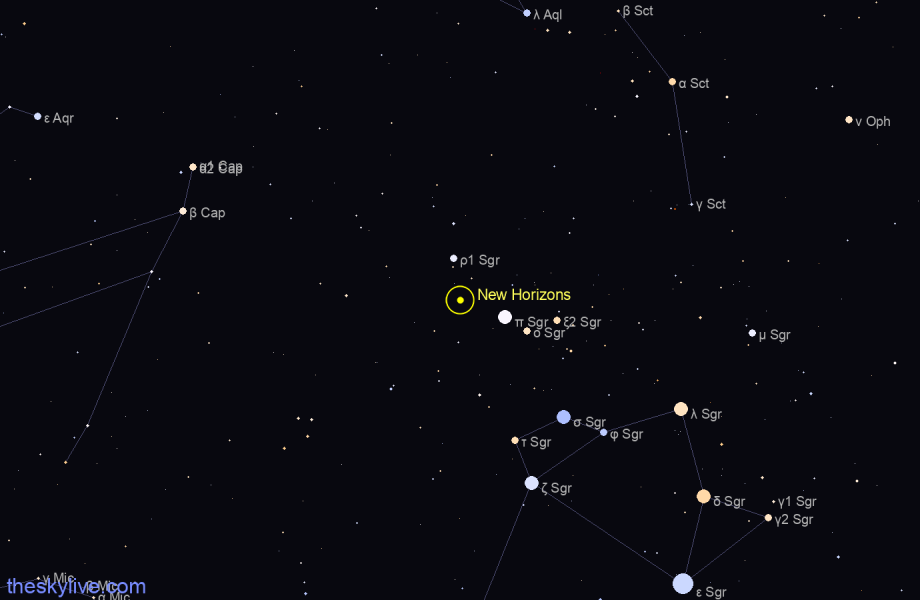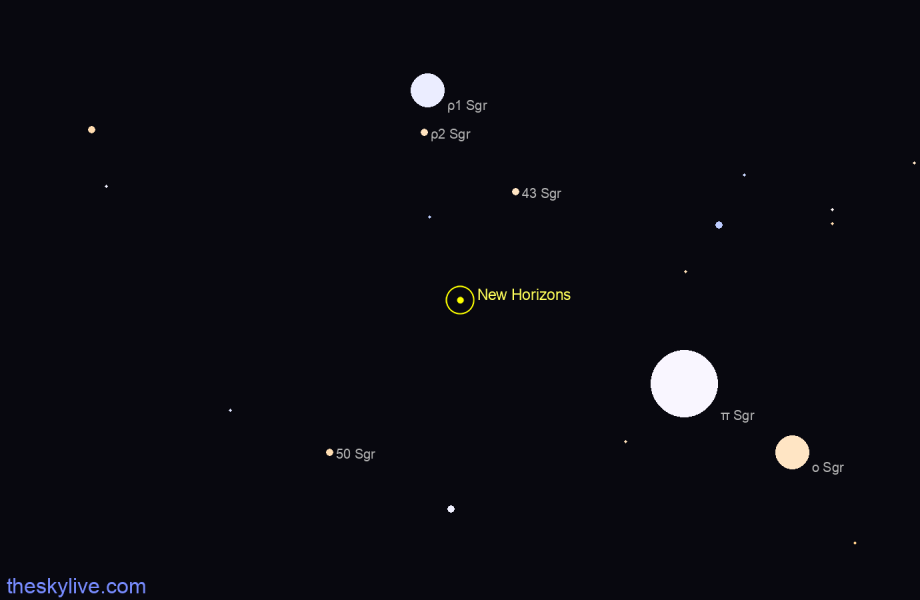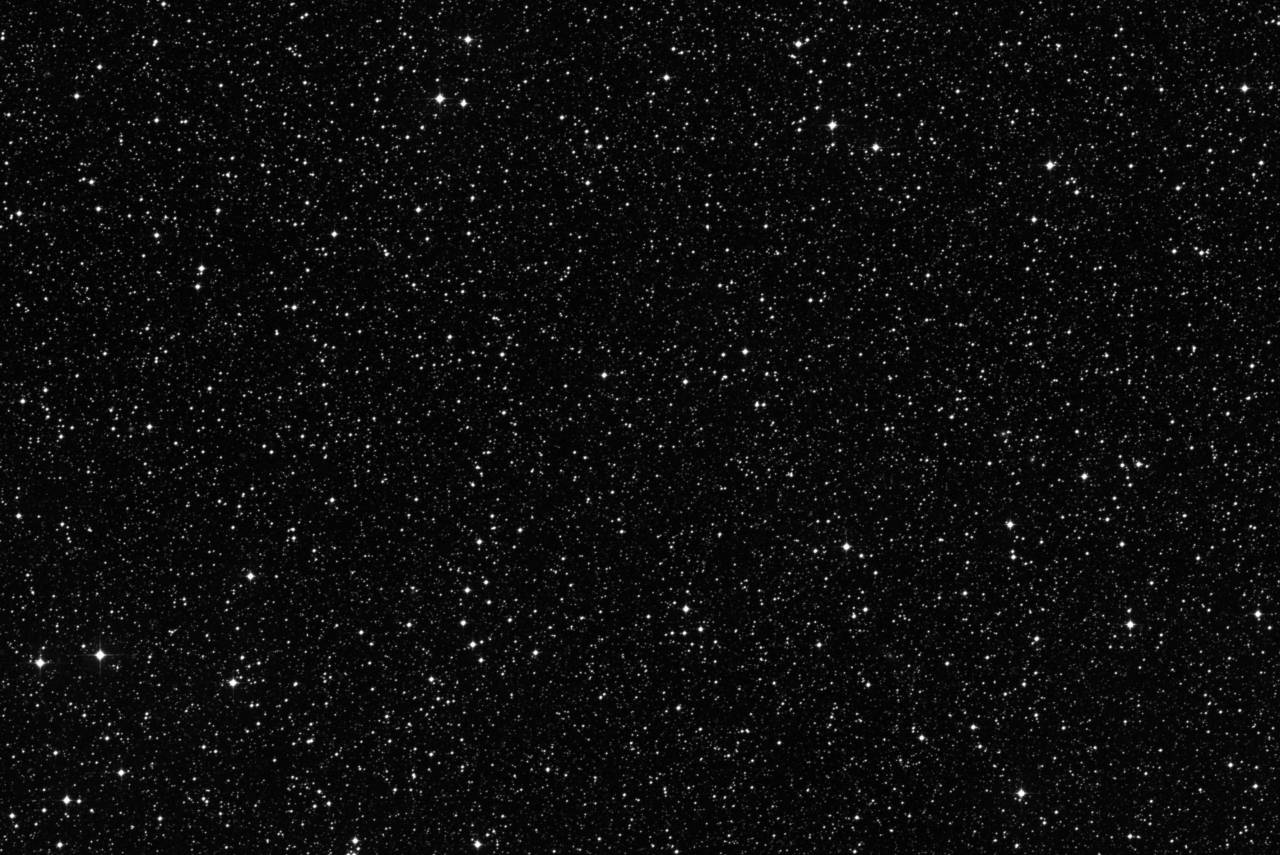New Horizons
New Horizons is a NASA space probe launched in January 2006 with the mission to explore the dwarf planet Pluto and the Kuiper Belt, the outermost region of the Solar System beyond the orbit of Neptune. The spacecraft completed its flyby of Pluto in July 2015, providing detailed images and data of the dwarf planet's surface, atmosphere, and moons. It then continued its journey into the Kuiper Belt, where it conducted a flyby of the Kuiper Belt Object (KBO) 2014 MU69, nicknamed "Ultima Thule," in January 2019, becoming the first spacecraft to visit a KBO. The New Horizons mission has provided valuable insights into the formation and evolution of the outer Solar System and expanded our knowledge of the icy bodies that reside there.
New Horizons is currently in the constellation of Sagittarius, at a distance of 8,744,086,871 kilometers from Earth.
View interactive star map
Today's rise, transit and set times of New Horizons from Greenwich, United Kingdom (all times relative to the local timezone Europe/London):
- New Horizons is below the horizon from Greenwich, United Kingdom .
- Go to interactive sky chart
If you need to access this information frequently for your observations, you can create a simple customized Quick Access page, so that you can easily bookmark it in your browser favorites or add a shortcut to your mobile phones' home screen.
New Horizons Position and Finder Charts
Field of view: 10x6 degrees
View fullscreen
Higher precision deep sky finder chart, 60 arcmin wide, showing where New Horizons is right now. Click on the image to see a more detailed fullscreen tracker view.
Also check out Where is New Horizons?, a page that provides all the information needed to find New Horizons in the sky and additional links to sky charts.
New Horizons Distance from Earth
The distance of New Horizons from Earth is currently 8,744,086,871 kilometers, equivalent to 58.450610 Astronomical Units. Light takes 8 hours, 6 minutes and 7.1343 seconds to travel from New Horizons and arrive to us.
The following chart shows the distance of New Horizons from Earth as a function of time. In the chart the distance data is measured in Astronomical Units and sampled with an interval of 1 day.
The value of the reported distance might be somewhat inaccurate around the times of closest approach for objects passing extremely close to Earth. The value of the distance of New Horizons from Earth is also available as a real time updated value in the Live Position and Data Tracker.
Closest Approach of New Horizons to Earth
Between 20 January 2006 and 31 December 2029, the closest approach of New Horizons to Earth happens on Fri Jan 20 2006 at a distance of 0.001369 Astronomical Units, or 204,840 kilometers:
NOTE: values for the closest approach are computed with a sampling interval of 1 day.
Visualization of New Horizons Orbit
This 3d orbit diagram is a feature of our 3D Solar System Simulator and shows the orbit of New Horizons with respect of the Sun and the orbits of the major planets. The position of New Horizons and the planets along their orbits in this diagram accurately represents the current configuration of the objects in the Solar System. This is an experimental feature and it requires a WebGL enabled browser. Please provide us feedback!
New Horizons 15 Days Ephemeris
The following table lists the ephemerides of New Horizons computed for the past and next 7 days, with a 24 hours interval. Click on each row of the table to locate New Horizons in our Online Planetarium at the chosen date.
| Date | Right AscensionR.A. | DeclinationDec. | MagnitudeMag | Constellation |
|---|---|---|---|---|
| 2024 Apr 18 | 19h 20m 48s | -20° 07’ 39” | N.A. | Sagittarius |
| 2024 Apr 19 | 19h 20m 48s | -20° 07’ 37” | N.A. | Sagittarius |
| 2024 Apr 20 | 19h 20m 48s | -20° 07’ 36” | N.A. | Sagittarius |
| 2024 Apr 21 | 19h 20m 47s | -20° 07’ 36” | N.A. | Sagittarius |
| 2024 Apr 22 | 19h 20m 47s | -20° 07’ 36” | N.A. | Sagittarius |
| 2024 Apr 23 | 19h 20m 45s | -20° 07’ 35” | N.A. | Sagittarius |
| 2024 Apr 24 | 19h 20m 44s | -20° 07’ 35” | N.A. | Sagittarius |
| 2024 Apr 25 | 19h 20m 44s | -20° 07’ 35” | N.A. | Sagittarius |
| 2024 Apr 26 | 19h 20m 43s | -20° 07’ 35” | N.A. | Sagittarius |
| 2024 Apr 27 | 19h 20m 41s | -20° 07’ 35” | N.A. | Sagittarius |
| 2024 Apr 28 | 19h 20m 40s | -20° 07’ 35” | N.A. | Sagittarius |
| 2024 Apr 29 | 19h 20m 39s | -20° 07’ 35” | N.A. | Sagittarius |
| 2024 Apr 30 | 19h 20m 38s | -20° 07’ 36” | N.A. | Sagittarius |
| 2024 May 01 | 19h 20m 36s | -20° 07’ 36” | N.A. | Sagittarius |





